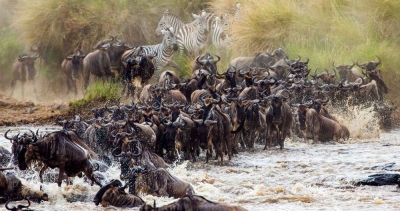
Several kinds of creatures migrate from one place to another in search of food, to escape harsh climate, or for breeding. Some of them make for specatacular visuals while some astound us with the sheer distance they cover.
Wildebeest
Every year in Africa, more than 10 lakh wildebeest, along with thousands of other herbivores and ungulates such as zebra and gazelle, go on a 1,000-km circuitous journey between the Serengeti National Park in Tanzania and Kenya’s Masai Mara Game Reserve, crossing many rivers, including the Mara river, braving swift currents and hungry crocodiles. As this drama unfolds, these animals are doggedly pursued by several land predators such as lions, cheetahs, and hyenas. The migration sees the animals moving to greener pastures in Kenya during the dry season in Serengeti. However, it is stated that the migration does not really have a beginning or end since through the year the animals keep moving to some region or the other falling within the migration route. Throughout the migration, several adults and newborns perish but much more survive only to keep alive the world’s most astounding spectacle that is said to have existed for centuries.
Butterflies
Did you know that every year butterfly migration happens twice a year in India between the Eastern Ghats and the Western Ghats? Among the main species that migrate are Dakhan Dark Blue Tiger, Oriental Blue Tiger, Double-branded Black Crow, and Indian Common Crow.
Around October-November just when the northeast monsoon sets in. the butterflies move from the Eastern Ghats to the Western Ghats, and breed there. The next generation of butterflies leaves the Western Ghats around April-May, just before the southwest monsoon, reaches the Easter Ghats, and breeds there. Then the next generation moves to the Western Ghats, and so the cycle continues.
Arctic tern
- Did you know that the Arctic tern makes the world’s longest migration?
- Flying from the Arctic to Antarctica and back, it totally covers a whopping 71.000 km in a year! According to the National Geographic, “Arctic terns are made for migration. They prefer to glide in the air for most of the year. They are so lightweight, they let ocean breezes carry them great distances without having to use a lot of energy flapping their wings. Arctic terns can sleep and eat, all while gliding.”
Red crabs
- On Christmas Island near Australia, a staggering number of red crabs running to millions leaves inland and migrates every year during the “wet season” (October to December) to the seaside to lay their eggs.
- The residents of the Island are very supportive of this phenomenon. They build bridges and underground tunnels to allow them to cross streets safely. In fact, during the peak migration season some roads are even closed!
Picture Credit : Google




